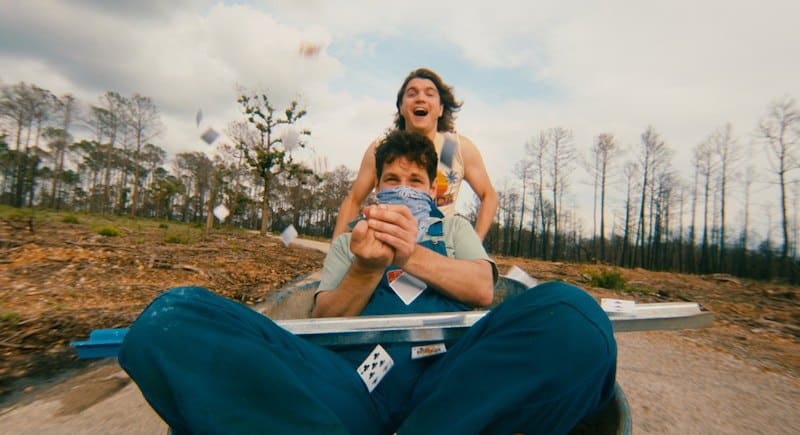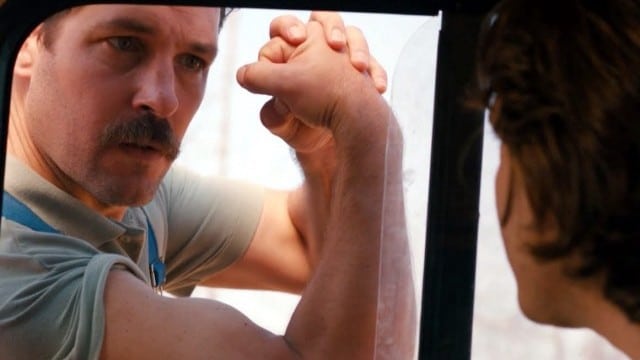
David Gordon Green’s Prince Avalanche is a small, simple film with a pair of recognizable faces in Paul Rudd and Emile Hirsch. It wasn’t seen by many people in theaters, and that’s a real shame because it remains one of the year’s best films. Audiences will get a second chance starting next Tuesday though when it comes to Blu-ray and DVD.
It’s the story of two men, Alvin and Lance, who discover a friendship and some unexpected self-realizations during an isolated summer spent working rural back roads after a devastating fire. They have nothing in common but loneliness, and while that sounds like a setup for drama the film finds joy in their conversations, disagreements, and personalities. After four acclaimed indie dramas and a mixed-bag of three studio comedies, this is easily Green’s best and purest film in years. Don’t let that scare you off though… it’s also incredibly funny.
Keep reading to see what I heard during David Gordon Green’s commentary for Prince Avalanche.
Prince Avalanche (2013)
Commentators: David Gordon Green (director), Paul Logan (Talent Driver), Hugo Garza (Set Production Assistant Craft Services)
1. The film opens with text detailing the devastating wildfires in 1987 that burned 43,000 forested acres to the ground along with 1600 homes and four lives. That’s a lie though created to enable the film’s period setting of 1988.
2. Paul Logan, whose job it was to drive Rudd and Hirsch to and from set, hates to drive.
3. This was David Gordon Green’s first film shot digitally, and he was pleased with the capabilities of the Alexa.
4. Green showed the original Icelandic film (Either Way) to Rudd and asked if he should secure the remake rights. Rudd was on board from that moment, and shortly after Hirsch called Green on an unrelated screenplay issue. “When I hung up the phone I’m like ‘wait a minute, I’m working on this script and thinking about who would be a good sidekick for Paul, and Emile’s a very unlikely co-star on a Paul Rudd movie and I started liking the unlikeliness of it.”
5. The sound of the mustard squeezing is actually a recording of Darius, the behind-the-scenes cameraman, farting. “He has gas, he has a real flatulence problem. Sometimes it’s funny, sometimes it’s disgusting. That one was a funny one.”
6. Green first met the late character actor Lance LeGault on the set of a Dodge car commercial he was directing while working on the script for this film. LeGault used to play with Elvis Presley apparently and is an accomplished musician. Green used one of his songs in his next film, Joe.
7. The line in the film where the truck driver tells Alvin (Rudd) that he shouldn’t smoke because he looks stupid was lifted from Green’s own experience visiting the set of The Assassination of Jesse James By the Coward Robert Ford. He was in a warming tent visiting friends during the train robbery scene, and Sam Shepard offered him a cigarette. The resulting exchange is mirrored exactly in this film. “It was an embarrassing moment to be called out by a master of performance and literature.”
8. Green shares that he and the costume designer had the concept of these guys being in “some apocalyptic version of the future from the past point of view as if Super Mario Brothers took over the military and there was a bloodbath, and this is the aftermath.”
9. Logan recalls that Rudd would share YouTube videos during downtime, but “he wouldn’t let anything buffer.” Logan told him he could pause the video and wait for it to fully load, but Rudd was having none of it.
10. Hirsch went on to film Lone Survivor after this, and apparently Peter Berg was hesitant to cast him due to his obesity. Green refers to Hirsch’s “turkey tits,” but wouldn’t go so far as to call him obese. For months afterward, Hirsch would send topless pics of himself to Green showing off his lean, hardened, Navy SEAL body.
11. The ‘birds in the truck’ scene wasn’t part of the script, but the original plan to set off firecrackers didn’t jive with the location’s recent fire issues. Green decided to go “the opposite of fire” which obviously, is doves.
12. Logan told Hirsch that he didn’t know why or how he got the job of “driver” because he hates to drive, and Hirsch replied “Do you want me to drive? I was Speed Racer.”
13. Green boots Logan off the commentary around the half hour mark for having too positive of an attitude and lacking stories about Hirsch’s hookers and blow. “Hey, I’m not mad at you,” he tells Logan. “I’m just a little disappointed.”

14. The scene of the older woman shoveling through the remains of her destroyed home was added to the script after the film’s producer met her doing just that while they were location scouting. Rudd walked the scene with the woman, Joyce Payne, and simply let her talk about her experience. “Never did we expect the kind of beauty, sadness, and strange humor of the scene.”
15. The following scene where Alvin pantomimes his way through the remains of a burned-out home was originally meant to played for laughs, a la Buster Keaton, but the tenderness of the preceding scene led them to take it more seriously.
16. One of the things Green enjoyed about making such a low budget film again was that they never had to rely on market analysis or test screenings and could instead shape the humor to their own tastes. “We knew at least 20–30 people would go see this in a theater, another 20–30 would buy it to watch it at home, and then that would cover the massive budget of this production.”
17. Green regrets kicking Logan out as he recalls that the driver had contributed the dialogue line, “Sometimes women get their hormones in a tizzy at competitive events.” He immediately asks Logan to rejoin the commentary.
18. The guy at the end of the film handling the chainsaw and missing an eye was also responsible for checking the set for snakes.
19. The scene where Lance reads the letter from Alvin’s girlfriend was one of the reasons why Green set the film in the ’80s. He wanted the “thoughtfulness of handwriting” for the emotional weight it brings over emails or texts.
20. The skunk eating the dead turtle was accomplished by purchasing the turtle shell from a flea market and filling it with melted Gummy Bears and maggots. The script originally called for a coyote eating a rabbit, but the former was too expensive while the latter was unavailable.
21. Hugo Garza recalls asking Green about a recurring motif in his films, to which the director replied “tighty whities?” Garza was actually referring to the repeating appearance of hammers. “There’s a big one in Joe, a brutal one in Joe,” says Green.
22. Garza says he’s heard two explanations for the film’s title, the first being the comic book reference and the second being that Alvin and Lance sounds like “avalanche.” He asks Green to confirm or deny, to which he replies the title came to him in a dream.
23. The woman on the phone playing Alvin’s girlfriend’s voice is director Lynne Shelton. The back of the woman’s head belongs to someone else.
24. Green challenges viewers to prove his assertion wrong that this is “the least R-rated R-rated movie ever made.” He points out the lack of sex, violence, and adult language, and then contrasts it to a summer filled with big studio films where thousands of people die per film and yet they all get a PG-13. He’s understandably frustrated.
25. The scene where Alvin runs and falls was actually Rudd running and accidentally falling. Green recalls a list of injuries throughout his films and TV work including James Franco’s head wound on Pineapple Express, broken ribs on Undertow, and Danny McBride’s nearly broken coccyx during the last season of Eastbound & Down. “You gotta wear a bulletproof vest when you work with me.”
26. When Alvin calls to Joyce in German he actually says “Would you like to join us on our avalanche?” Green changed the subtitle from avalanche to adventure though because he felt it was trying too hard to connect with the title. He apologizes to viewers who understand German.
Best in Commentary
- Logan: “I’ve worn that shirt that Emile is wearing.”
- Green: “There’s no cussing in this movie unless you say ‘fingering’ is cussing.”
- Green: “I didn’t want to use the Icelandic title, Either Way, because I knew the second we advertised the movie about two dudes in the woods called Either Way it was going to one very specific impression.”
- Green: “That middle finger is why we’re an R-rated film.”
Final Thoughts
David Gordon Green is an engaging speaker, but his selection of commentary cohorts didn’t originally instill much confidence. Logan and Garza prove pleasant and conversational though, and Green does a fantastic job interacting with them and making them a real part of the commentary. It remains a sweetly humorous and heartfelt film, and Green’s affection for it and his cast and crew is apparent.
Check out more commentary commentary in the Commentary Commentary archives
Related Topics: Commentary Commentary
